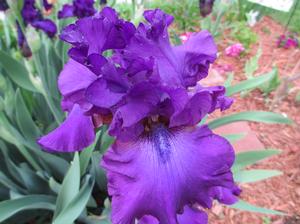Bearded irises are the royalty of my spring garden with their tall, frilly blooms and sword-like foliage.
 They add a perfect upright element to the garden, and they come in such a huge variety of colors that you are unlikely to ever get bored growing them. Bearded Iris bloom after spring bulbs and prior to summer flowering plants, providing color and beauty to every part of your garden. If you’ve planted your bearded irises in good soil in a sunny spot, there’s not much you need to do, day-to-day, to keep them happy.
They add a perfect upright element to the garden, and they come in such a huge variety of colors that you are unlikely to ever get bored growing them. Bearded Iris bloom after spring bulbs and prior to summer flowering plants, providing color and beauty to every part of your garden. If you’ve planted your bearded irises in good soil in a sunny spot, there’s not much you need to do, day-to-day, to keep them happy.
Bearded irises really grow best in full sun. You’ll get the most numerous, larger blooms if they get at least eight hours of sun per day. Bearded irises prefer fertile, well-drained soil. The best time to plant irises in Michigan is in July through September — this allows the plants to get established before winter.
Bearded Irises grow from a root called a rhizome, an enlarged, elongated sort of lumpy bulb-like affair that is often right on the surface of the ground. It is very important to plant your rhizomes at or just barely below the surface of the ground. Irises should be planted so the tops of the rhizomes are visible and the roots are spread out facing downwards in the soil. Tamp the soil firmly to anchor the rhizomes until new roots begin to grow, and water well. If you’re starting with a potted iris plant, simply plant it as deeply as it was growing in its container. It is a common mistake to plant Irises too deeply.
Newly planted rhizomes need moisture so their root systems develop. Once established, irises should be watered when the top three inches of soil dry out. The watering frequency will depend to a great extent on your environment. Over watering of Irises is a common mistake.
It is extremely important to keep your iris beds free of weeds and fallen leaves so the rhizomes may bask in the sun. Spacing plants so there is good air circulation will help prevent diseases.
You’ll also want to divide your bearded irises every three to four years to keep them growing strong. Once you start seeing decreased bloom, it’s time to divide.
Basic Planting Steps
Step (1) Build up a small mound of soil in the center of the planting hole.
Step (2) Center the rhizome on the soil mound and spread out the roots on either side.
Step (3) Firm the soil around the roots. Newly planted rhizomes should be watered thoroughly.
Be Patient — Irises are perennials and require time to grow. New growth may be noticeable within 2-3 weeks and begins with a new center leaf in the fan. Depending upon the maturity of the rhizome and the geographical location, there may or may not be blooms the first spring.


